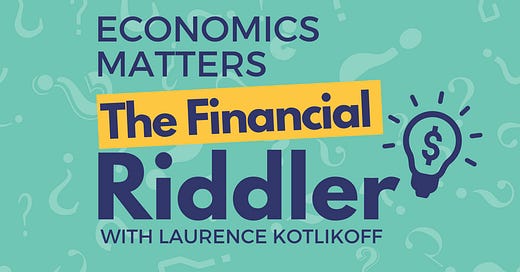Time to put away the NY Times Spelling Bee and play The Financial Riddler, where losing is winning. Either way, you’ll learn something important that will likely inform/improve your financial decisions.
To avoid peeking at answers, scroll slowly and stop at “And the answer is.”
Then check how you did. Also, play the prior riddlers posted at larrykotlikoff.substack.com.
Please share The Financial Riddler with your kids, grandparents, mother-in-law, boss, and members of Congress. They need time off from their video games.
The Financial Crisis Inquiry Commission (FCIC) was established in 2009 to investigate the causes of the Great Recession. It includes this summary.
There was an explosion in risky subprime lending and securitization, an unsustainable rise in housing prices, widespread reports of egregious and predatory lending practices, dramatic increases in household mortgage debt, and exponential growth in financial firms’ trading activities, unregulated derivatives, and short-term “repo” lending markets, among many other red flags.
Are any of these alleged Great Recession culprits actually guilty as charged? I.e., could they, on their own or in combination have caused the Great Recession?
a) Yes
b) No
c) Maybe
And the Answer Is …
My answer, as conveyed in this easy-to-read Milken Review article, is b, i.e., no. I argue that the alleged origins of the Great Recession (GR) are either (a) unsupported by the facts, (b) inconsistent with widely accepted economic theory or (c) descriptions of outcomes, not causes. Moreover, the GR was not particularly “great,” implying that its very title is part of the recession’s self-generated hysteria. My view of what produced this latest in a long history of U.S. banking failures and economic downturns? Pure misinformed panic, facilitated and sustained by financial leverage and financial opacity, flipped the economy’s equilibrium. Before the GR, we had a functional economy thanks to everyone acting on that belief. Then, seemingly overnight, we had the opposite — a dysfunctional economy based on collective action grounded in hysteria.
What’s the Federal Reserve’s current projection of inflation for 2023?
a) 8.7 percent
b) 7.2 percent
c) 5.5 percent
d) 3.5 percent
3) 2.9 percent
And the Answer Is …
The answer is d. The Federal also predicts the unemployment rate will average 4.6 percent in 2023, up from 3.5 percent now.
What is the current real yield on 30-year TIPS (Treasury Inflation-Protected Securities)?
a) 3.28 percent
b) 2.91 percent
c) 1.43 percent
d) -0.79 percent
And the Answer Is …
The answer is c. This is the highest 30-year real rate observed in a decade. For those wanting to lock in a “safe” return on their investments, including as part of running Upside Investing in MaxiFi Planner, this may be the time to invest in long-term TIPS. The reason I put safe in quotes is that the inflation component of the nominal return on TIPS is subject to taxation, both federal and state. But with inflation coming down and expected long-term inflation (the difference between the 30 year nominal Treasury rate and the 30-year TIPS yield) at only 1.23 percent , TIPS may be the place to invest a good chunk of your retirement assets — for the long-term. If you hold TIPS to maturity, you’ll get the 1.23 per-tax real return for sure independent of short-term fluctuations in their prices. When the price of a TIP goes down, it’s yield goes up, leaving its inflation-adjusted coupon payment unchanged.
What nominal interest rate is Uncle Sam now charging on new issuances of Parent Plus Loans?
a) 7.54 percent
b. 6.11 percent
c. 4.19 percent
d) 3.19
e) -1.89 percent
And the Answer Is …
The answer is a — 7.54 percent. This is a huge real borrowing rate, namely 6.31 percent, given that the market believes inflation, long term, will be just 1.23 percent. Parent Plus loans permit parents to borrow on behalf of their children’s education — to an unlimited degree. The maximum students, themselves, can borrow, at least with respect to federal student loans, is $31,000. If your child is paying the sticker price at a pricey school, that’s enough to cover about one-eighth of their four-year college costs. Consequently, Parent Plus loans are a huge and astronomically expensive part of the student loan crisis. Plus, parents may be taking out these loans assuming their children will repay or forcing their kids to repay by a) not reducing their spending, b) leaving their kids less when they pass, or c) leaving themselves with more support needs for their kids to cover if they live too long. If you take a read of Money Magic, you’ll find a chapter entitled, “Don’t Borrow for College.” This applies to parents. There is a 40 percent chance your child, for whom you are borrowing, won’t make it through college. This, plus a safe real borrowing rate that‘s five times the safe long-term TIPS rate likely makes Parent Plus loans a massive financial mistake.





Hi Jerry,
Many :)s.
If the debt ceiling isn't raised, we'll see interest rates start soaring and the market start collapsing. It could trigger a financial panic. The market will quantify the cost of crazy.
XO, Larry
Hi and thanks. It would lead to rates rising day after day as long as the ceiling isn't raised. The stock market would tank. It could trigger a financial panic. As we've seen, they are easy to trigger.
Cheers, Larry